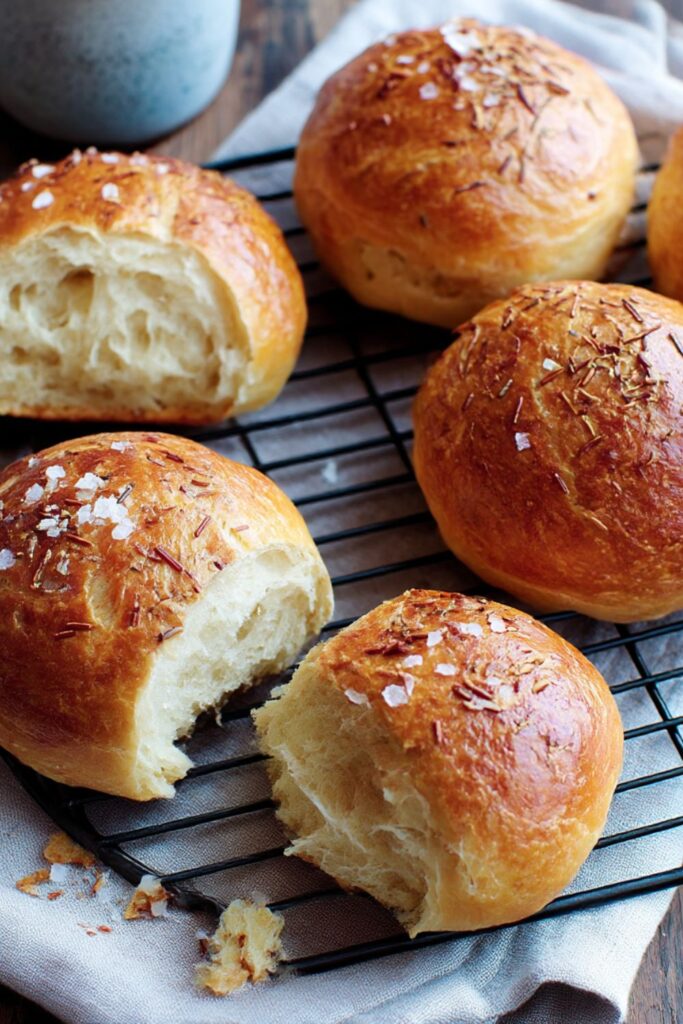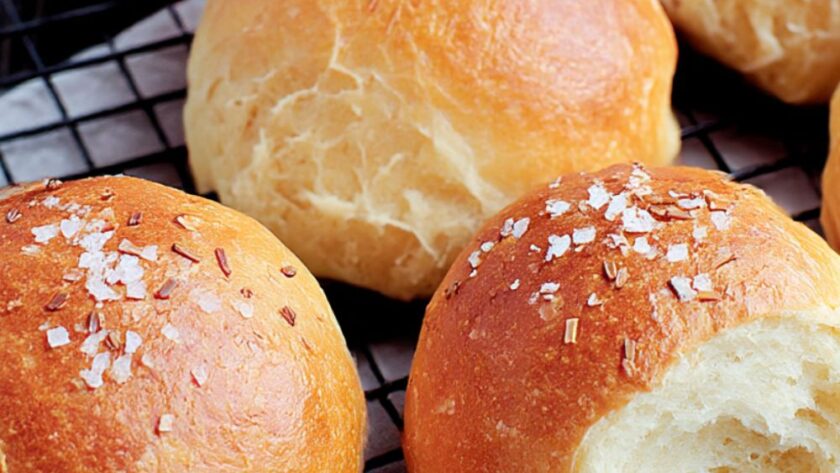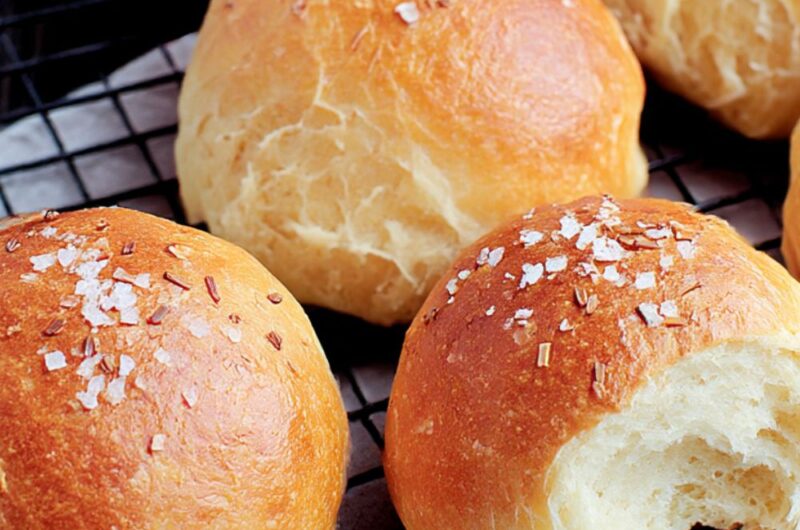This Bath Buns Recipe is a sweet and buttery bake, which is made with fresh yeast and a hidden sugar cube center. It’s a classic British bake, ready in about 2 hours and 45 minutes.
Bath Buns Ingredients
- 250ml milk
- 14g fresh yeast or 7g dried yeast
- 450g strong white flour, plus extra for dusting
- 30g sugar
- 225g butter, at room temperature
- optional: 1 tablespoon caraway seeds
- 12 rough-cut white sugar cubes
- 1 large free-range egg
For the Milk Glaze:
- 1 tablespoon milk
- 2 tablespoons sugar
For the Topping:
- 4 rough-cut white sugar cubes
- optional: 1 tablespoon caraway seeds
How To Make Bath Buns
- Activate the yeast: Gently warm the milk until it is tepid (lukewarm), then stir in the yeast and set aside.
- Mix the dough base: In a large bowl or a stand mixer, combine the flour, sugar, and 1 teaspoon of sea salt. Add the room temperature butter and work it in with your fingertips or the dough hook until the mixture resembles fine breadcrumbs.
- Combine and rest: Stir in the caraway seeds (if using) and the yeasty milk. The dough will seem wet; do not add more flour. Let the dough rest for 10 minutes.
- Knead the dough: Turn the dough out onto a floured surface and knead for 8 to 10 minutes by hand (or 6 to 8 minutes in a mixer) until it is smooth and elastic.
- First proof: Place the dough in a clean bowl, cover with a damp tea towel, and leave in a warm place for 1 hour and 30 minutes, or until it has doubled in size.
- Shape the buns: Preheat the oven to 190ºC/gas 5 and line a baking tray. Knock back the dough and divide it into 12 equal pieces. Roll each into a ball, push a sugar cube into the center, and pull the dough around to completely enclose it.
- Second proof: Place the buns on the prepared tray, cover with a damp cloth, and let them prove in a warm place for 30 minutes until they have doubled in size.
- Bake and glaze: Brush the buns with a beaten egg and bake for 15 to 20 minutes until golden. While they bake, prepare the glaze by warming the milk and sugar until the sugar dissolves.
- Finish and serve: As soon as the buns come out of the oven, brush them generously with the hot milk glaze. Sprinkle with crushed sugar cubes and more caraway seeds (if using). Serve warm.

Recipe Tips
- Why is my dough so sticky? This is a very enriched, wet dough due to the high butter content. Trust the process and avoid adding extra flour during the initial mix. It will become smooth and manageable after proper kneading.
- How do I know the buns are baked through? A perfectly baked bun will be a deep golden-brown color on top and will sound hollow when you tap its bottom.
- What is the best way to prove dough? A warm, draft-free place is essential. You can use an airing cupboard, a spot near a warm radiator, or a slightly warm oven that has been turned off.
- Can I use regular granulated sugar cubes? Yes, if you can’t find rough-cut sugar cubes, standard ones will work just fine for the center and the topping.
What To Serve With Bath Buns
These rich, sweet buns are a treat on their own, but are traditionally served with:
- A cup of hot tea
- A simple spread of good quality butter
- A dollop of clotted cream
How To Store Bath Buns
- Room Temperature: The buns are best eaten on the day they are made but will last for up to 3 days in an airtight container. Gently reheat them in a warm oven or microwave before serving.
- Freeze: It is best not to freeze these buns, as the texture can change significantly upon thawing.
Bath Buns Nutrition Facts
- Calories: 320 kcal
- Carbohydrates: 40g
- Protein: 6g
- Fat: 15g
- Sodium: 210mg
Nutrition information is estimated and may vary based on ingredients and cooking methods used.
FAQs
What are Bath buns?
A Bath bun is a traditional sweet, rich, yeasted bun from the city of Bath in England. It’s known for its buttery dough and often contains a lump of sugar in the middle and a sprinkle of caraway seeds.
Do I have to use the caraway seeds?
No, the caraway seeds are optional. They add a traditional, slightly anise-like flavor, but if you’re not a fan, you can simply leave them out for a purely sweet and buttery bun.
Why is there a sugar cube inside the bun?
This is a classic feature of a Bath bun. As the bun bakes, the sugar cube melts, creating a sweet, syrupy pocket in the center of the bread.
Try More Recipes:
Bath Buns Recipe
Course: BreakfastCuisine: BritishDifficulty: Easy12
25
minutes20
minutes320
kcalA classic British tea-time treat, these rich, buttery buns have a hidden molten sugar cube in the center and are finished with a sweet, shiny glaze.
Ingredients
250ml milk
14g fresh yeast (or 7g dried)
450g strong white flour
30g sugar
225g butter, room temperature
1 tsp salt
13 rough-cut sugar cubes
1 large egg, beaten
For Glaze: 1 tbsp milk, 2 tbsp sugar
Optional: 1 tbsp caraway seeds
Directions
- Warm the milk, stir in the yeast, and set aside.
- Combine flour, sugar, and salt; rub in the butter until it resembles breadcrumbs.
- Mix in the yeasty milk and knead the sticky dough for 8-10 minutes until smooth.
- Cover and let prove for 1.5 hours until doubled in size.
- Divide into 12 balls, push a sugar cube into the center of each, and seal.
- Arrange on a baking tray, let prove for 30 minutes, then brush with egg wash.
- Bake at 190ºC/gas 5 for 15-20 minutes. Brush hot buns with a sugar-milk glaze and top with crushed sugar.
Notes
- The initial dough will be very wet and sticky; this is normal for an enriched dough. Avoid the temptation to add lots of extra flour.
- Ensuring the sugar cube is completely sealed inside the dough will prevent it from leaking out during baking.
- The milk glaze should be brushed onto the buns while they are still hot from the oven to create the classic shiny finish.

